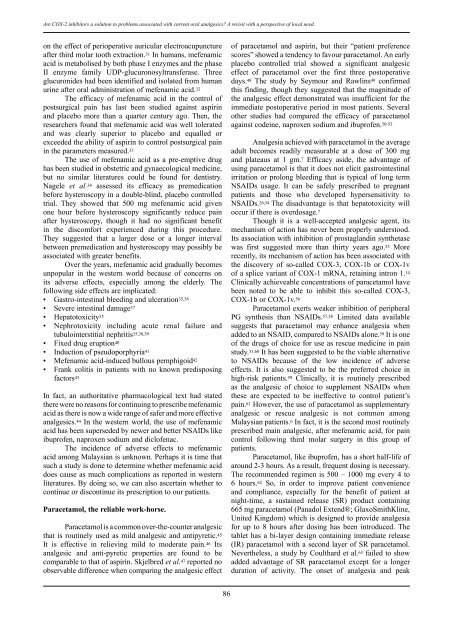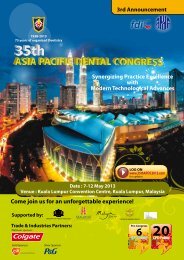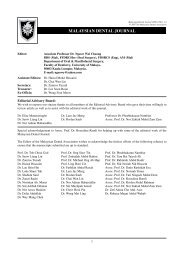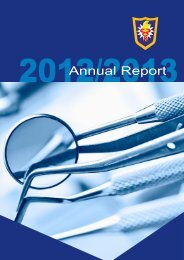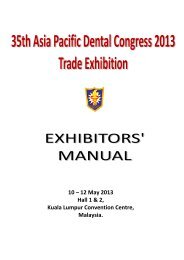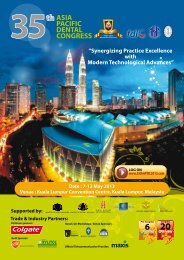PDF( 8mb) - Malaysian Dental Association
PDF( 8mb) - Malaysian Dental Association
PDF( 8mb) - Malaysian Dental Association
You also want an ePaper? Increase the reach of your titles
YUMPU automatically turns print PDFs into web optimized ePapers that Google loves.
Are COX-2 inhibitors a solution to problems associated with current oral analgesics? A revisit with a perspective of local need.on the effect of perioperative auricular electroacupunctureafter third molar tooth extraction. 31 In humans, mefenamicacid is metabolised by both phase I enzymes and the phaseII enzyme family UDP-glucuronosyltransferase. Threeglucuronides had been identified and isolated from humanurine after oral administration of mefenamic acid. 32The efficacy of mefenamic acid in the control ofpostsurgical pain has last been studied against aspirinand placebo more than a quarter century ago. Then, theresearchers found that mefenamic acid was well toleratedand was clearly superior to placebo and equalled orexceeded the ability of aspirin to control postsurgical painin the parameters measured. 33The use of mefenamic acid as a pre-emptive drughas been studied in obstetric and gynaecological medicine,but no similar literatures could be found for dentistry.Nagele et al. 34 assessed its efficacy as premedicationbefore hysteroscopy in a double-blind, placebo controlledtrial. They showed that 500 mg mefenamic acid givenone hour before hysteroscopy significantly reduce painafter hysteroscopy, though it had no significant benefitin the discomfort experienced during this procedure.They suggested that a larger dose or a longer intervalbetween premedication and hysteroscopy may possibly beassociated with greater benefits.Over the years, mefenamic acid gradually becomesunpopular in the western world because of concerns onits adverse effects, especially among the elderly. Thefollowing side effects are implicated:• Gastro-intestinal bleeding and ulceration 35,36• Severe intestinal damage 37• Hepatotoxicity 35• Nephrotoxicity including acute renal failure andtubulointerstitial nephritis 35,38,39• Fixed drug eruption 40• Induction of pseudoporphyria 41• Mefenamic acid-induced bullous pemphigoid 42• Frank colitis in patients with no known predisposingfactors 43In fact, an authoritative pharmacological text had statedthere were no reasons for continuing to prescribe mefenamicacid as there is now a wide range of safer and more effectiveanalgesics. 44 In the western world, the use of mefenamicacid has been superseded by newer and better NSAIDs likeibuprofen, naproxen sodium and diclofenac.The incidence of adverse effects to mefenamicacid among <strong>Malaysian</strong> is unknown. Perhaps it is time thatsuch a study is done to determine whether mefenamic aciddoes cause as much complications as reported in westernliteratures. By doing so, we can also ascertain whether tocontinue or discontinue its prescription to our patients.Paracetamol, the reliable work-horse.Paracetamol is a common over-the-counter analgesicthat is routinely used as mild analgesic and antipyretic. 45It is effective in relieving mild to moderate pain. 46 Itsanalgesic and anti-pyretic properties are found to becomparable to that of aspirin. Skjelbred et al. 47 reported noobservable difference when comparing the analgesic effectof paracetamol and aspirin, but their “patient preferencescores” showed a tendency to favour paracetamol. An earlyplacebo controlled trial showed a significant analgesiceffect of paracetamol over the first three postoperativedays. 48 The study by Seymour and Rawlins 49 confirmedthis finding, though they suggested that the magnitude ofthe analgesic effect demonstrated was insufficient for theimmediate postoperative period in most patients. Severalother studies had compared the efficacy of paracetamolagainst codeine, naproxen sodium and ibuprofen. 50-53Analgesia achieved with paracetamol in the averageadult becomes readily measurable at a dose of 300 mgand plateaus at 1 gm. 7 Efficacy aside, the advantage ofusing paracetamol is that it does not elicit gastrointestinalirritation or prolong bleeding that is typical of long termNSAIDs usage. It can be safely prescribed to pregnantpatients and those who developed hypersensitivity toNSAIDs. 26,54 The disadvantage is that hepatotoxicity willoccur if there is overdosage. 7Though it is a well-accepted analgesic agent, itsmechanism of action has never been properly understood.Its association with inhibition of prostaglandin synthetasewas first suggested more than thirty years ago. 55 Morerecently, its mechanism of action has been associated withthe discovery of so-called COX-3, COX-1b or COX-1vof a splice variant of COX-1 mRNA, retaining intron 1. 14Clinically achieveable concentrations of paracetamol havebeen noted to be able to inhibit this so-called COX-3,COX-1b or COX-1v. 56Paracetamol exerts weaker inhibition of peripheralPG synthesis than NSAIDs. 57,58 Limited data availablesuggests that paracetamol may enhance analgesia whenadded to an NSAID, compared to NSAIDs alone. 59 It is oneof the drugs of choice for use as rescue medicine in painstudy. 31,60 It has been suggested to be the viable alternativeto NSAIDs because of the low incidence of adverseeffects. It is also suggested to be the preferred choice inhigh-risk patients. 59 Clinically, it is routinely prescribedas the analgesic of choice to supplement NSAIDs whenthese are expected to be ineffective to control patient’spain. 61 However, the use of paracetamol as supplementaryanalgesic or rescue analgesic is not common among<strong>Malaysian</strong> patients. 6 In fact, it is the second most routinelyprescribed main analgesic, after mefenamic acid, for paincontrol following third molar surgery in this group ofpatients.Paracetamol, like ibuprofen, has a short half-life ofaround 2-3 hours. As a result, frequent dosing is necessary.The recommended regimen is 500 – 1000 mg every 4 to6 hours. 62 So, in order to improve patient convenienceand compliance, especially for the benefit of patient atnight-time, a sustained release (SR) product containing665 mg paracetamol (Panadol Extend®; GlaxoSmithKline,United Kingdom) which is designed to provide analgesiafor up to 8 hours after dosing has been introduced. Thetablet has a bi-layer design containing immediate release(IR) paracetamol with a second layer of SR paracetamol.Nevertheless, a study by Coulthard et al. 63 failed to showadded advantage of SR paracetamol except for a longerduration of activity. The onset of analgesia and peak86


